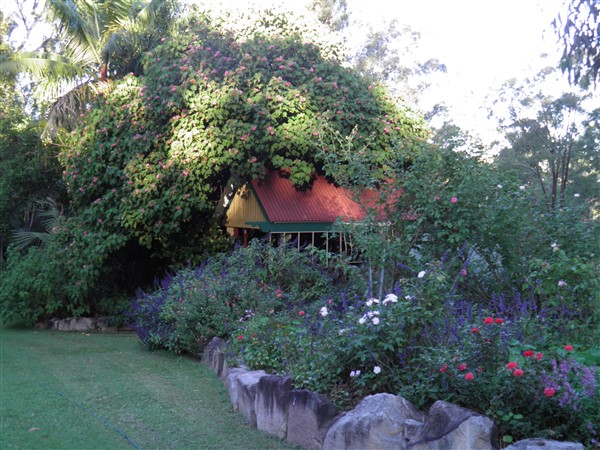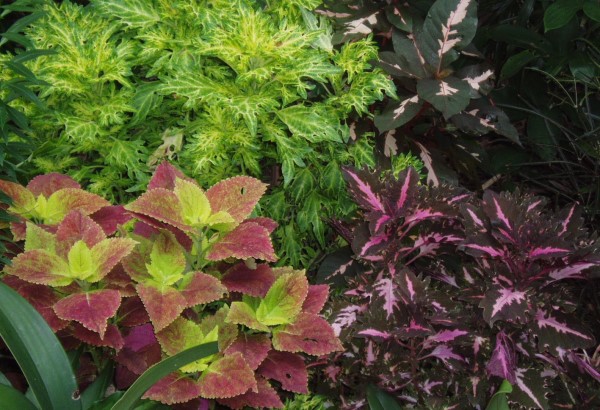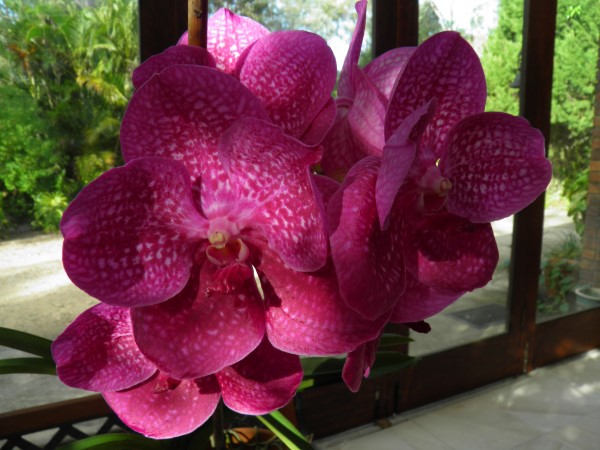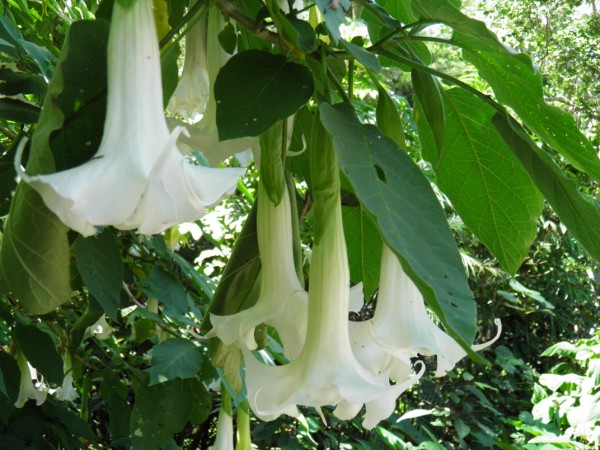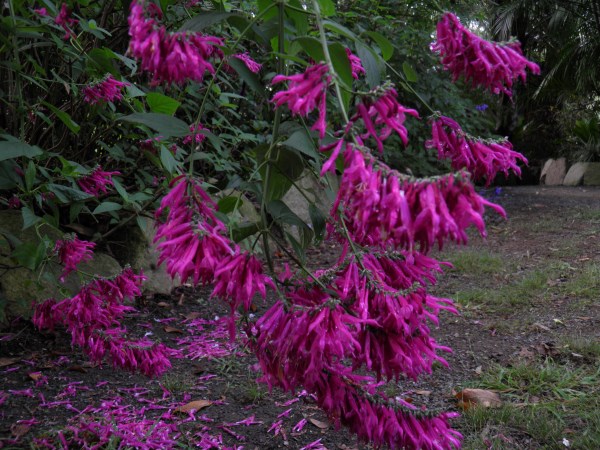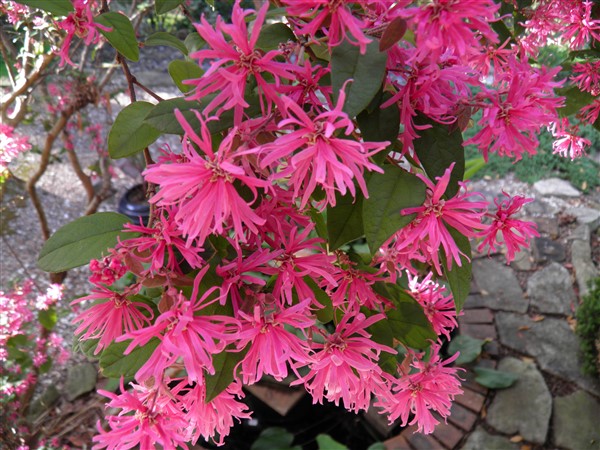|
Shrubs/Trees Abelia Abutilon Allamanda Ardisia Bougainvillea Barleria Brugmansia Buddleija Callicarpa (berries) Carphalea kirondron Clerodendron nutans Costus Dahlia Imperialis Dichorisandra thrysiflora Dombeya tiliacaea Eranthemum Frangipani rubra Frangipani ‘pudica’ Galphimia Hedychium Heliconias Hibiscus Holmskioldia Ipomoea carnea Ixoras Justicia carnea Koelreuteria Loropetalum Magnolia Little Gem Megaskapasma erythrochlamys Mussaenda Odontonema Oleander Otacanthus Quisqualis indica Rosemary Roses Strobilanthes "pink bells" Thunbergia erecta Tibouchina Westringia Xanthostemon chrysanthus Zingiber spectabile |
Perennials Ajania Pacifica Alternanthera Angelonia Anthurium Asters Celosia argentea var spicata Chrysanthemums Cleome Senorita Coreopsis Cosmos Dianthus Gerberas Heliotrope Lavender Leonitis Medinilla Nasturtium Nepeta Nicotiana Pachystachys Pelargonium Pennisetum Burgundy Pentas Plectranthus Russellia Salvia involucrata Salvia Iodanthe Salvia leucantha Salvia madrensis Salvia mexicana Salvia purpurea Sedum Solidago (Golden Rod) Tagetes Tree Dahlias Tulbaghia Verbena Whitfieldia |
Orchids Brassia Bulbophyllum Cattleya Dendrobium Hard Cane Miltonia Vanda Zygopetalum Bromelaids Aechmea Billbergia Cryptanthus Guzmania Hohenbergia Neoregelia Vriesa Bulbs Belamcanda chinensis Dahlias Gladioli Japanese Anemones Hippeastrum reticulatum Lycoris Zephranthes candida Water Garden Alocasia esculenta Arrowhead Thalia geniculata Water Lilies Vines Aeschynanthus Clerodendrum splendens Cobaea Scandens Dalechampia roezliana Hoya Ipomoea horsfaillaea Stephonotis Mandevilla Maurandya Mansoa alliacea (garlic vine) Clerodendron Phaseolus caracalla |


BILLBERGIA PYRAMIDALIS
COLEUS
CATTLEYA ORCHID
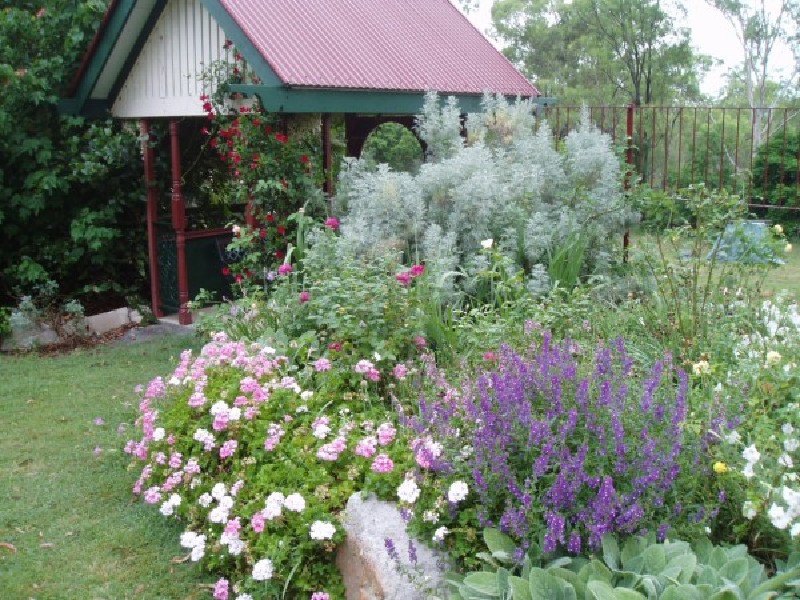
WHAT IS FEATURING IN THE GARDEN IN APRIL:
Wow what a start to Autumn with Cyclone Alfred and half our annual rainfall in a couple of weeks, the garden really is BULKED UP!!
THE GARDEN AFTER CYCLONE ALFRED
Amazingly, there was very little damage. A lot of leaves, twigs and branches down and most of the branches that did fall were dead. We did have a big wind from the south that blew a big branch from the Fiddlewood tree and also blew a woody vine off the top of a tank in the same area. The vine needed a good cut back anyway and the Fiddlewood tree branch was easily cut up. The top half of a big tree also blew down in a paddock, which will make good firewood for winter.
The chippings that we put on the paths worked very well. There was some movement but not as much wash as there would have been with soil or crusher dust.
Considering the number of streams we had running through the gardens, the water got away very quickly and without any erosion or problems.
All the tanks are full and overflowing and all the overflows worked very well, including the dam overflows. We did get over 300mm of rain over the 2 or 3 days after Cyclone Alfred made landfall.
None of the big trees moved and even the 2 dead ones shed only a few branches. I do feel that the top storey of the big trees, the second storey of the smaller bushier trees and shrubs all protect each other. The roots are of course deep into the ground and very stable due to the soft rock and blue metal base.
The trees dahlias did go over in the wind and some of the heliconias and gingers did bend, but they all survived. I will not be turning the watering system on in the garden for a while to allow all the plant roots to go deep into the ground to follow the moisture.
I had a few Cattleya and Vanda orchids out and the flowers stood up to the constant rain. With all this moisture and the weather still warm there will be a lot more growth.
COLEUS
Coleus add so much colour to the garden and they certainly love the summer wet weather. Take cuttings of them to make sure you always have some on hand to pop into the garden where you need some colour.
I particularly like the lime green one, but there are many colours and patterned leaves and some with unusual formed leaves. If you don’t cut off their seed heads you may get some new seedling colours which is very exciting.
The autumn flowering Salvias, Iodanthe, Purpurea and Involucrata are taking a little longer coming into flower, but will look brilliant with their big arching canes. These can be trimmed back to the ground after flowering.
VEGETABLES
With the cooler temperatures, seedlings of tomatoes, pak choi, silverbeet, eggplant, and kale will also take off. These vegetables look great amongst the flower garden as well as the vegetable garden, but they all need full sun.
Snow Peas can go in now as can tomatoes. Both of these need a trellis, so put that in first. Snow Peas are best soaked in water overnight before planting.
Herbs do especially well during this time, so pop in some basil, dill, parsley, mustard, oregano, tarragon, borage and thyme. Not only are they great in cooking but they also look great in the garden amongst the perennials if you don’t have a vegetable garden.
Garlic and perennial onion can also be planted if not already in the ground.
ORCHIDS
Make sure that Phalaenopsis and Hard cane dendrobiums have a warm spot for winter. They don’t like night temperatures to drop below 10 degrees Celsius. April is the time we start closing the doors on the orchid house at night to keep the temperatures higher than 10 degrees Celsius. The orchid house is not heated but with all the other ‘tropicals’ growing in there it creates a micro climate which helps keep the humidity and warmth higher than outside.
All the orchids can take more light in winter as it is not as harsh as the summer sun. The Softcane Dendrobiums in particular can take full winter sun and that will also encourage flowering and no extra watering. The wisterias are losing their leaves now. This means that all the orchids in the courtyard will slowly get more and more light which of course means more flowers.
Good Gardening
Jan
THE GARDEN AFTER CYCLONE ALFRED
Amazingly, there was very little damage. A lot of leaves, twigs and branches down and most of the branches that did fall were dead. We did have a big wind from the south that blew a big branch from the Fiddlewood tree and also blew a woody vine off the top of a tank in the same area. The vine needed a good cut back anyway and the Fiddlewood tree branch was easily cut up. The top half of a big tree also blew down in a paddock, which will make good firewood for winter.
The chippings that we put on the paths worked very well. There was some movement but not as much wash as there would have been with soil or crusher dust.
Considering the number of streams we had running through the gardens, the water got away very quickly and without any erosion or problems.
All the tanks are full and overflowing and all the overflows worked very well, including the dam overflows. We did get over 300mm of rain over the 2 or 3 days after Cyclone Alfred made landfall.
None of the big trees moved and even the 2 dead ones shed only a few branches. I do feel that the top storey of the big trees, the second storey of the smaller bushier trees and shrubs all protect each other. The roots are of course deep into the ground and very stable due to the soft rock and blue metal base.
The trees dahlias did go over in the wind and some of the heliconias and gingers did bend, but they all survived. I will not be turning the watering system on in the garden for a while to allow all the plant roots to go deep into the ground to follow the moisture.
I had a few Cattleya and Vanda orchids out and the flowers stood up to the constant rain. With all this moisture and the weather still warm there will be a lot more growth.
COLEUS
Coleus add so much colour to the garden and they certainly love the summer wet weather. Take cuttings of them to make sure you always have some on hand to pop into the garden where you need some colour.
I particularly like the lime green one, but there are many colours and patterned leaves and some with unusual formed leaves. If you don’t cut off their seed heads you may get some new seedling colours which is very exciting.
The autumn flowering Salvias, Iodanthe, Purpurea and Involucrata are taking a little longer coming into flower, but will look brilliant with their big arching canes. These can be trimmed back to the ground after flowering.
VEGETABLES
With the cooler temperatures, seedlings of tomatoes, pak choi, silverbeet, eggplant, and kale will also take off. These vegetables look great amongst the flower garden as well as the vegetable garden, but they all need full sun.
Snow Peas can go in now as can tomatoes. Both of these need a trellis, so put that in first. Snow Peas are best soaked in water overnight before planting.
Herbs do especially well during this time, so pop in some basil, dill, parsley, mustard, oregano, tarragon, borage and thyme. Not only are they great in cooking but they also look great in the garden amongst the perennials if you don’t have a vegetable garden.
Garlic and perennial onion can also be planted if not already in the ground.
ORCHIDS
Make sure that Phalaenopsis and Hard cane dendrobiums have a warm spot for winter. They don’t like night temperatures to drop below 10 degrees Celsius. April is the time we start closing the doors on the orchid house at night to keep the temperatures higher than 10 degrees Celsius. The orchid house is not heated but with all the other ‘tropicals’ growing in there it creates a micro climate which helps keep the humidity and warmth higher than outside.
All the orchids can take more light in winter as it is not as harsh as the summer sun. The Softcane Dendrobiums in particular can take full winter sun and that will also encourage flowering and no extra watering. The wisterias are losing their leaves now. This means that all the orchids in the courtyard will slowly get more and more light which of course means more flowers.
Good Gardening
Jan
THIS MONTH
IN THE GARDEN
with Jan
APRIL
IN THE GARDEN
with Jan
APRIL
VANDA ORCHID
BRUGMANSIA
LOROPETALUM RUBRA
Let nature be your guide
SALVIA IODANTHE
